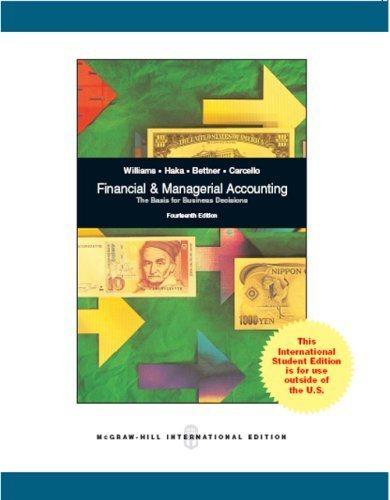Simon Teguh is considering investing in a vending machine operation involving 20 vending machines located in various
Question:
Simon Teguh is considering investing in a vending machine operation involving 20 vending machines located in various plants around the city. The machine manufacturer reports that similar vending machine routes have produced a sales volume ranging from 800 to 1,000 units per machine per month. The following information is made available to Teguh in evaluating the possible profitability of the operation.
1. An investment of $45,000 will be required, $9,000 for merchandise and $36,000 for the 20 machines.
2. The machines have a service life of five years and no salvage value at the end of that period.
Depreciation will be computed on the straight-line basis.
3. The merchandise (candy and soft drinks) retails for an average of 75 cents per unit and will cost Teguh an average of 25 cents per unit.
4. Owners of the buildings in which the machines are located are paid a commission of 5 cents per unit of candy and soft drinks sold.
5. One person will be hired to service the machines. The salary will be $1,500 per month.
6. Other expenses are estimated at $600 per month. These expenses do not vary with the number of units sold.
Instructions
a. Determine the unit contribution margin and the break-even volume in units and in dollars per month.
b. Draw a monthly cost-volume-profit graph for sales volume up to 1,000 units per machine per month.
c. What sales volume in units and in dollars per month will be necessary to produce an operating income equal to a 30 percent annual return on Teguh’s $45,000 investment? (Round to the nearest unit)
d. Teguh is considering offering the building owners a flat rental of $30 per machine per month in lieu of the commission of 5 cents per unit sold. What effect would this change in commission arrangement have on his monthly break-even volume in terms of units?
Contribution margin is an important element of cost volume profit analysis that managers carry out to assess the maximum number of units that are required to be at the breakeven point. Contribution margin is the profit before fixed cost and taxes... Salvage Value
Salvage value is the estimated book value of an asset after depreciation is complete, based on what a company expects to receive in exchange for the asset at the end of its useful life. As such, an asset’s estimated salvage value is an important...
Step by Step Answer:

Financial And Managerial Accounting
ISBN: 12
14th International Edition
Authors: Jan R. Williams, Joseph V. Carcello, Mark S. Bettner, Sue Haka, Susan F. Haka





